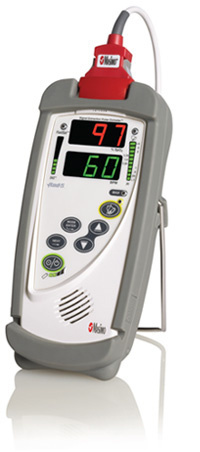Pulse Oximeter

It is a non-invasive method for monitoring a person's O2 saturation.
In its most common (transmissive) application mode, a sensor device is placed on a thin part of the patient's body, usually a fingertip or earlobe, or in the case of aninfant, across a foot. The device passes two wavelengths of light through the body part to a photodetector. It measures the changing absorbance at each of thewavelengths, allowing it to determine the absorbances due to the pulsing arterial blood alone, excluding venous blood, skin, bone, muscle, fat, and (in most cases) nail polish.[1]
Reflectance pulse oximetry may be used as an alternative to transmissive pulse oximetery described above. This method does not require a thin section of the person's body and is therefore well suited to more universal application such as the feet, forehead and chest, but it also has some limitations. Vasodilation and pooling of venous blood in the head due to compromised venous return to the heart, as occurs with congenital cyanotic heart disease patients, or in patients in the Trendelenburg position, can cause a combination of arterial and venous pulsations in the forehead region and lead to spurious SpO2 (Saturation of peripheral oxygen) results.
